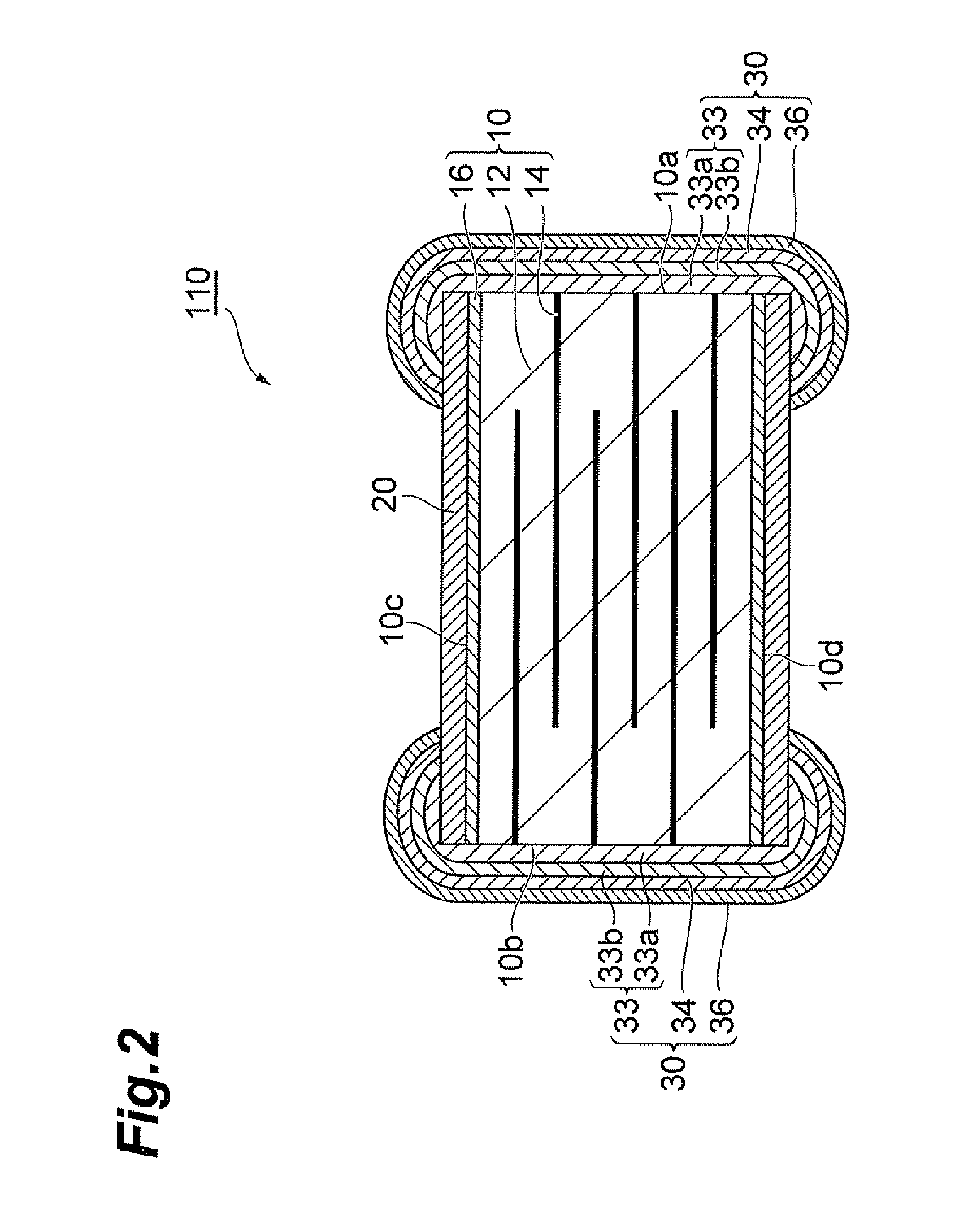Multilayer PTC thermistor
- Summary
- Abstract
- Description
- Claims
- Application Information
AI Technical Summary
Benefits of technology
Problems solved by technology
Method used
Image
Examples
example 1-1
Fabrication of Multilayer PTC Thermistor
Fabrication of Ceramic Body
[0078]As oxide powders there were prepared BaCO3 powder, TiO2 powder, Gd2O3 powder and Nb2O5 powder. The oxide powders were each weighed out in an amount for a final barium titanate-based compound composition according to formula (7). The weighed oxide powders were placed in a nylon pot together with purified water and a pulverizing ball and mixed for 6 hours and dried to obtain a mixed powder.
(Ba0.9985Gd0.0015)0.995(Ti0.9985Nb0.0015)O3 (7)
[0079]After subsequent pre-molding of the mixed powder, it was held for 4 hours in air at 1150° C. and calcined to obtain a calcined body. The calcined body was shredded to form a calcined powder with a mean particle size of 1 μm. The prepared calcined powder was placed in a nylon pot together with a solvent, a binder, a plasticizer, purified water and a pulverizing ball, and mixed therewith for 20 hours using a triple roll to obtain a green sheet slurry. The mixing ratios of the ...
example 1-2
[0100]A multilayer PTC thermistor was obtained in the same manner as Example 1-1, except that the glass powder used was zinc-based glass (main component: ZnO) containing 59.7 mass % ZnO, 27.6 mass % B2O3, 9.4 mass % SiO2 and 3.3 mass % Al2O3, instead of bismuth-based non-alkaline glass, and the firing temperature for formation of the glass layer was changed to 710° C.
[0101]The multilayer PTC thermistor comprised a ceramic body, a glass layer on its main side, and external electrodes each having a ground electrode layer, a tin plating layer and a nickel plating layer on the end faces, in that order from the ceramic body side. This was used as a multilayer PTC thermistor for Example 1-2. Multilayer PTC thermistors were fabricated by the same procedure, to produce a total of 1000 multilayer PTC thermistors. The softening temperature of the glass component in the glass layer of each multilayer PTC thermistor of Example 2-1 was 631° C., and the crystallization temperature was 750° C. The...
example 1-3
[0104]A multilayer PTC thermistor was obtained in the same manner as Example 1, except that the glass powder used was bismuth-based non-alkaline glass (main component: Bi2O3) containing 84 mass % Bi2O3, 9 mass % ZnO, 4 mass % SiO2 and 3 mass % Al2O3, and the firing temperature for formation of the glass layer was changed to 490° C. The multilayer PTC thermistor comprised a ceramic body, a glass layer on its main side, and external electrodes each having a ground electrode layer, a tin plating layer and a nickel plating layer on the end faces, in that order from the ceramic body side.
[0105]This was used as a multilayer PTC thermistor for Example 1-3. Multilayer PTC thermistors were fabricated by the same procedure, to produce a total of 1000 multilayer PTC thermistors. The softening temperature of the glass component in the glass layer of each multilayer PTC thermistor of Example 1-3 was 410° C., and the crystallization temperature was 470° C. The obtained multilayer PTC thermistor w...
PUM
| Property | Measurement | Unit |
|---|---|---|
| Percent by mass | aaaaa | aaaaa |
| Temperature | aaaaa | aaaaa |
| Temperature | aaaaa | aaaaa |
Abstract
Description
Claims
Application Information
 Login to View More
Login to View More - R&D
- Intellectual Property
- Life Sciences
- Materials
- Tech Scout
- Unparalleled Data Quality
- Higher Quality Content
- 60% Fewer Hallucinations
Browse by: Latest US Patents, China's latest patents, Technical Efficacy Thesaurus, Application Domain, Technology Topic, Popular Technical Reports.
© 2025 PatSnap. All rights reserved.Legal|Privacy policy|Modern Slavery Act Transparency Statement|Sitemap|About US| Contact US: help@patsnap.com



